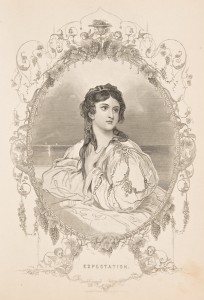
In the Illman Brothers’ “Expectation,” the female subject’s clothing loses shape the further away from her face you go, making it clear that her visage is the main focus of the work. Looking expectant is hard to visualize, in my opinion. It’s a trait you see in domesticated pets or in children who are waiting for gifts or fun outings. Maybe the woman is waiting patiently for the artist illustrating her to be finished more than anything else. Though, it’s not hard to deduce that Victorian women lead less active lifestyles than their male counterparts, especially those belonging to a higher class. The background appears almost amorphous; I interpret a sun surrounding the top of her head, either sky or clouds going down to her shoulders, a muted horizon to the right of her, and reflecting water. She must be waiting for her significant other to return from somewhere, as she has her hands (or at least her left hand) placed over her chest.
At the Trout Gallery, we briefly discussed the intricate ornamentation framing the portrait. The ovular shape of the frame suggests a mirror, highlighting the motif of the “woman as object” aesthetic that male artists go gaga for. And this one in particular is a sensual plaything, a fantasy. Grapes and cherubs (or whatever those angel babies are called) holding what looks like martini glasses only enhance the mood. I am of course reminded of Walter falling in love with Laura while making her his muse in the beginning of The Woman in White, as well as a more fragile Laura hoping for him to return from his errands when she loses her memory. The image also reminds me of a couple of lines from Christina Rossetti’s “In an Artist’s Studio”: “We found her hidden just behind those screens, / That mirror gave back all her loveliness” (3-4). The man who gazes at this etching is meant to siphon that loveliness (longing, yet perfectly poised) to feed his desire, to spurn him on.